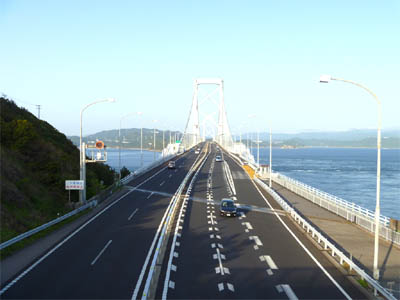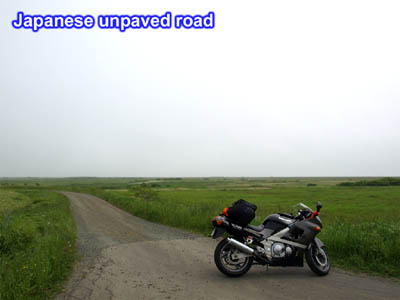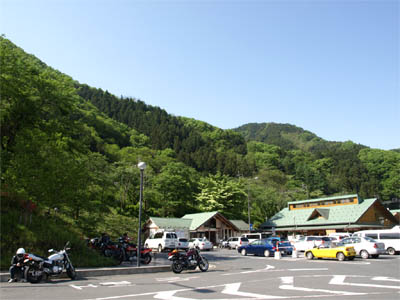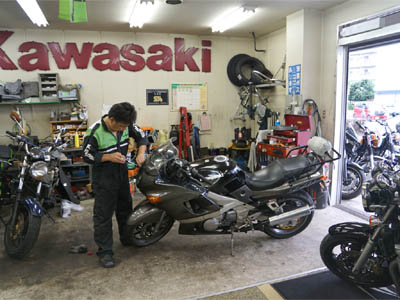How to ride a motorcycle in japan?
1. Helmet
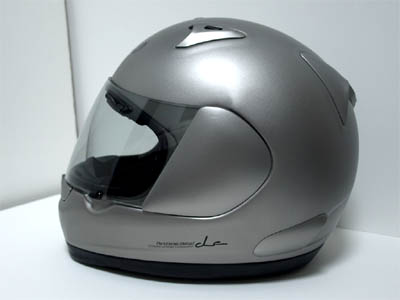
If you ride a motorcycle on a public road in Japan, you must wear a helmet. Please be aware that riding a motorcycle without wearing a helmet is against the law.
2. Lane
Left-hand traffic

Japan is Left-hand traffic. If your country is Right-hand traffic, it may take some time to get used to. Be careful not to accidentally enter the right lane when you turn right at an intersection.
3. Traffic signs
Stop Signs
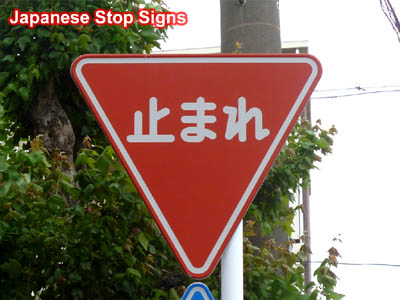
In Japan, there are traffic signs written in Japanese. The red inverted triangle sign is a stop sign. "止まれ" means STOP. In recent years, this stop sign has been replaced by a sign in English.
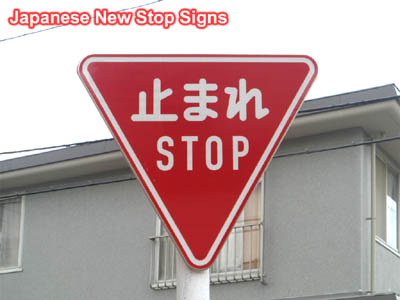
This is the new Japanese stop sign in English. This English traffic sign has been gradually increasing in number.
One Way Do Not Enter Signs
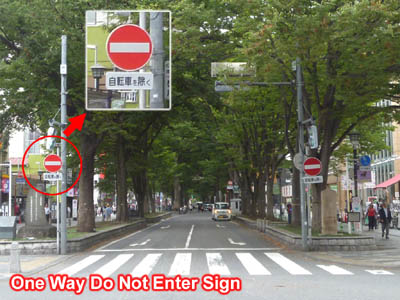
Signs with white bars in red circles are signs of "One Way Do Not Enter". This sign has the same shape as an international traffic sign.
Speed Limit Road Traffic Signs

These are speed limit traffic signs. The speed limit for Japanese general roads is 60km. There are 40 km and 50 km speed limit signs on urban and mountain roads. School zones and residential areas are marked with a 30km speed limit.
Some countries are required to stop on the road in front of the school, but Japan has no such rule.
Conditional traffic sign
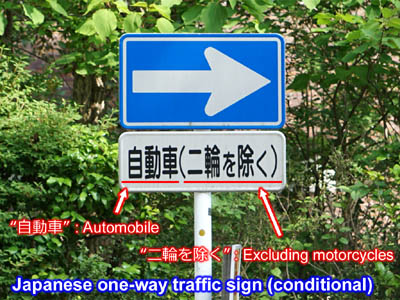
Applicable conditions may be written in Japanese under traffic signs. This is written in Japanese, so it is difficult for non-Japanese riders to understand. The image on the left is a one-way traffic sign, but excluding motorcycles. There are various types of condition texts.
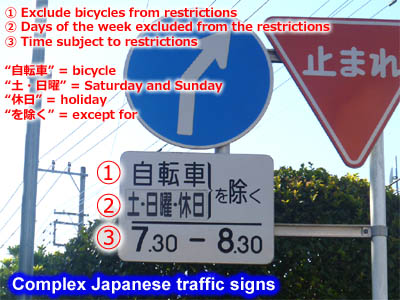
There are more complex traffic signs in Japan. Three conditions are described in Japanese on this traffic sign.
1. Exclude bicycles from restrictions
2. Exclude Saturdays, Sundays and public holidays from restrictions
3. The restriction is only from 7:30 to 8:30
Such traffic signs are often placed on the roads where students walk to school.
4. Intersection
Japanese Intersection
Right Turn Lane at Intersection
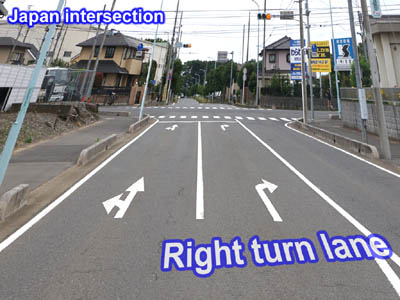
At intersections on large roads, there is a right turn lane. This is the same as having a left turn lane in country of Right-hand traffic.
5. Signal
Right Turn Signal
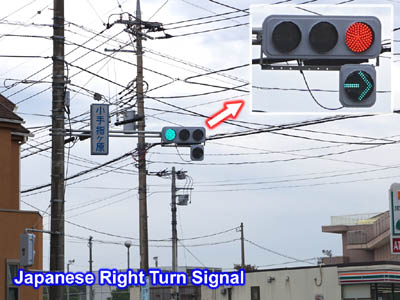
At the intersection in Japan, there is a right turn signal with a green right arrow. This allows you to safely turn right.
6-lights Traffic Signals
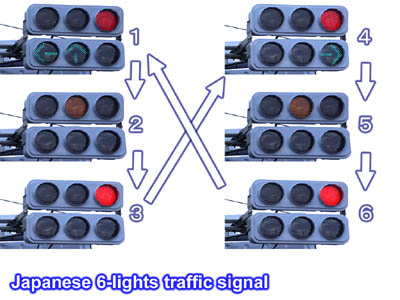
At intersections in Japan, there are traffic signals with three types of arrows. In this signal, the green signal at the upper left may not light. This signal will generally light in the following order.
- The green left arrow and up arrow signals are lights up.
- The yellow signal lights up.
- The red signal lights up.
- The green right arrow signal lights up.
- The yellow signal lights up.
- The red signal lights up.
Single light traffic signal

In Japan, there is a single-light signal at an intersection in the suburbs where traffic is light. A single-light traffic signal has a flashing red or yellow light. If the red light is blinking, you have to stop temporarily.
No Left Turn on Red Signal

In a country of Right-hand traffic, red lights can also turn to the right. But, you cannot turn left when the red signal lights up in Japan.
Red signal lights up at the same time
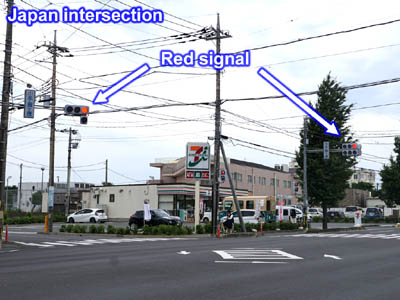
In some countries, the moment the red signal light comes on, the other side's green signal light may come on. But, even if the red light comes on, the other green light does not come on immediately in Japan. Therefore, both red signal lights may be on.
Time lag traffic signal
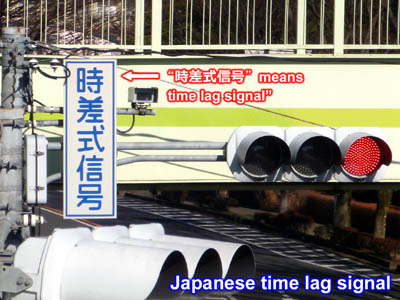
In Japan, there is a traffic signal that two signals facing each other do not change from blue to red at the same time. This traffic signal is installed at the intersection with many vehicles turning right. This type of traffic signal is fitted with a sign that says "時差式信号" in Japanese.
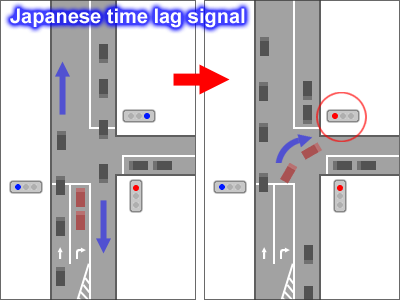
In the time lag traffic signal, the two signals facing each other at the intersection are both blue at first. First, the traffic signal that allows you to go straight or turn left will turn red. At this time, only the traffic signal on the other side turns blue, so cars and motorcycles can safely turn right. This is the mechanism of the time lag traffic signal in Japan.
Push-button signal for walking traffic crosswalk
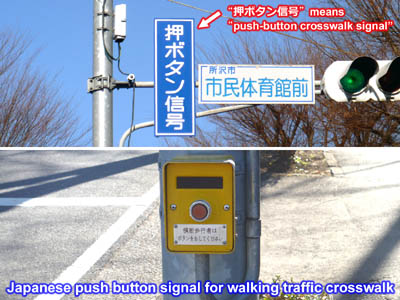
Pedestrian traffic signals may have push buttons. If a pedestrian crosses the road, press this button. This type of traffic signal is fitted with a sign that says "押ボタン信号" in Japanese.
Push Button Signal for Motorcycles
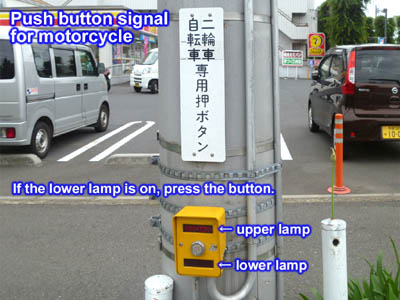
At small intersections, there are push buttons for motorcycles and bicycles. If the lower light is on, press the button to turn on the upper light. If the upper lamp is on, the green signal light will turn on after a while. This push button is located next to the stop line at the intersection. There are few this push buttons at intersections in urban areas.
Beside the stopped car

While signal is red, there is a motorcycle that runs beside the car and comes out in front of the car. Be careful not to touch.
6. General Roads
Route Signs
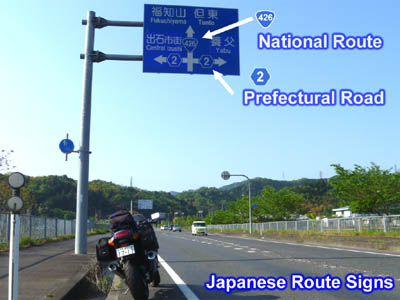
There are two types of route number signs in Japan. The shape of the national road sign is a blue inverted triangle. The shape of the prefectural road sign is a hexagon. The shapes of both signs are similar.
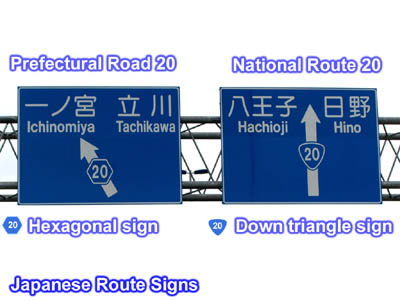
This is an example of a traffic sign that is very misleading. On the left is the traffic sign for prefectural road 20. On the right is the traffic sign for Route 20. This is a rare case, but the roads may be different even if they have the same road number.
Street Name
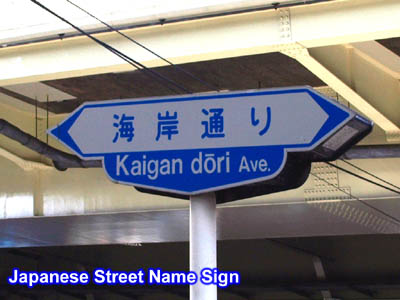
In countries other than Japan, street names are very important. However, only some of the big roads have street names in Japan. There is no street name on the small road.
Intersection Name
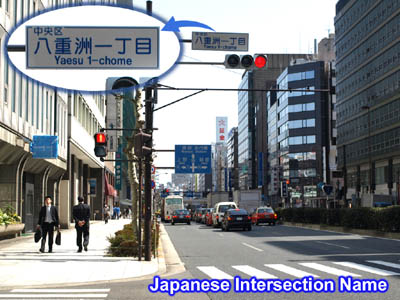
The Japanese intersection has intersection name. The name of the intersection is written in blue above the traffic signal light.
Narrow Mountain Road

There are many narrow roads in Japan except in central Tokyo. In particular, roads in mountainous areas are narrow. Be careful about oncoming vehicles.
Unpaved Road
Railroad Crossing
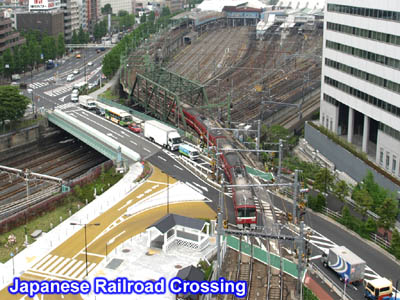
There are many railway lines in Japan. Therefore, there are many railroad crossings. If you ride motorcycle in the city center on a weekday morning, you may have to wait for a long time at the railroad crossing.
Tram Road
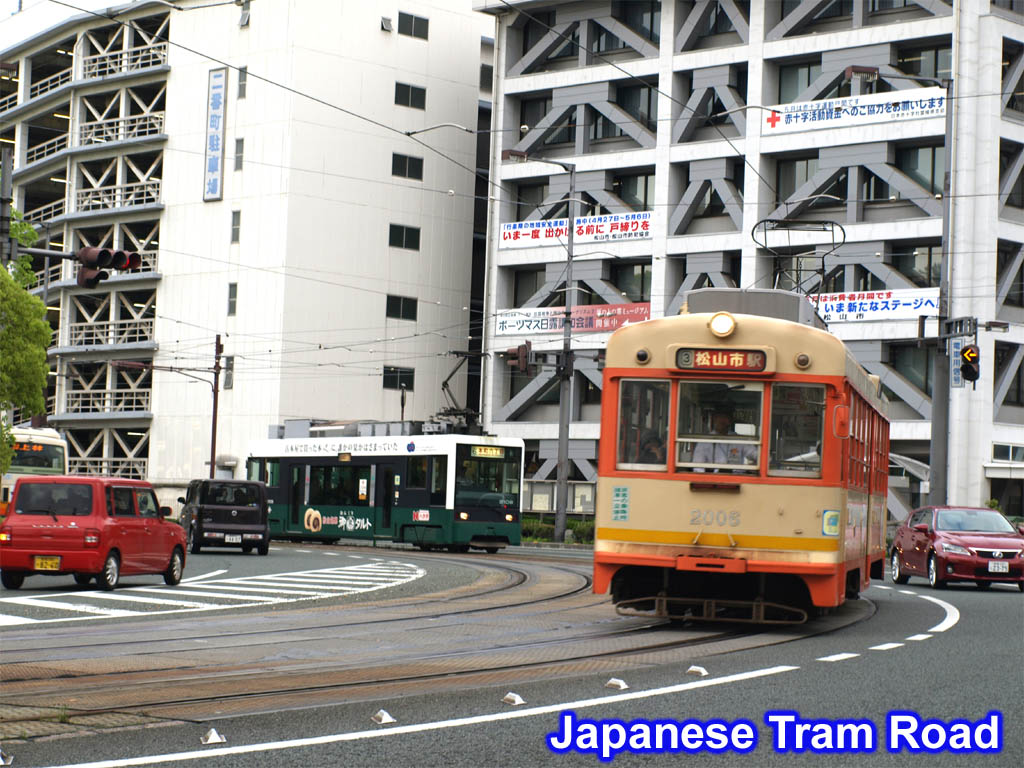
Tramways also run on Japanese roads. Japanese trams are almost the same as trams in other countries.
Traffic Jam

Roads in Japan are frequently jammed. In particular, the roads on weekday mornings and evenings are congested. Avoid peak times if possible.
Road Closed Signs
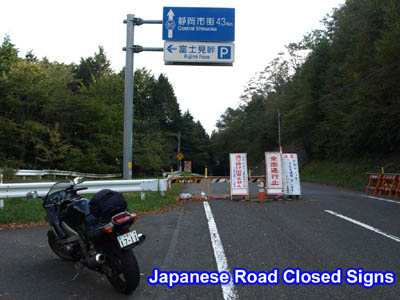
Roads in mountainous areas may be closed due to falling rocks or landslides. However, the Road Closed signs are written in Japanese. Please refer to the picture on the left.
7. Expressway
Toll Road

There are large number of expressways in Japan, which can significantly reduce the travel time to the destination. Let's make good use of the highway.
Toll Gate
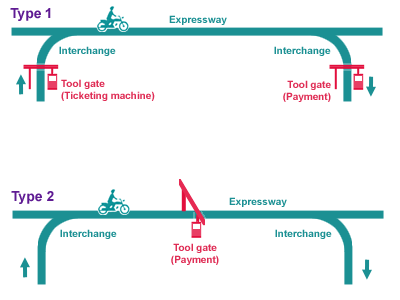
There are two main types of toll gates in Japan. The most common type has two gates at the interchange. First, you will receive a ticket when you enter the expressway. Then, when you get out of the expressway, give the ticket and pay the fee. This is because the fare varies depending on the distance traveled.
The second type has a toll gates on the expressway. This is because the fare is flat regardless of the mileage. Toll gates at the start and end of expressways are also of this type. This type of toll gates is also used when connecting to expressways with different jurisdictions.
ETC (Electronic Toll Collection)

We recommend that you attach an ETC (Electronic Toll Collection) device to your motorcycle. ETC is a system that collects tolls without stopping your motorcycle without cash. There are two types of lanes, purple and green, at the toll booths of Japanese Expressways. The purple lane is for ETC and can be passed without stopping at the toll booth. If your motorcycle does not have an ETC device attached, go through the green lanes. On the green lane, there is a clerk who collects tolls.
Interchange
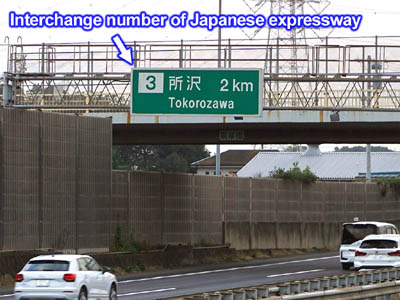
Interchanges on Japanese highways are numbered. Don't worry if you can't read the Japanese interchange name on the traffic sign. Check the interchange number you get off the expressway in advance.
Forked Road

After passing the expressway toll gate, there is a forked road. If you don't know which way to go, stop your motorcycle on the shoulder of a road and check the map.
Rest Facilities
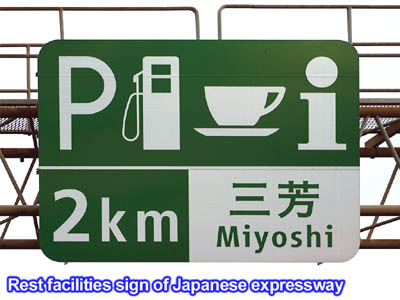
There are many rest facilities on the Japanese expressways. A guide sign is installed in front of the rest facility. Guide signs indicate the presence or absence of gas stations and restaurants.

There are two types of rest facilities on Japanese expressway. "SA" is an abbreviation of the Service Area. SA is a relatively large rest facility, usually with gas stations. "PA" is an abbreviation of the Parking Area. PA is a relatively small rest facility. There are many rest facilities on the highway in Japan, so there is almost no problem.
Motorcycle Parking Area

There are parking spaces for motorbikes at rest facilities on expressway in Japan. Parking space for motorcycle is located by the road closest to the building.
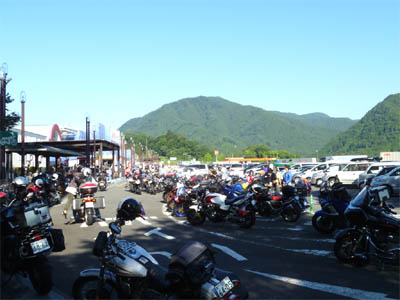
On holidays, many motorcycle are parked in the parking space for motorcycles. Park your motorcycle out of the way.
Toll Roads Toll Charges
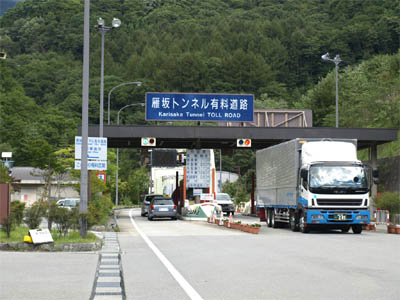
In Japan, there are toll roads in addition to expressways. Toll rate table may be written in Japanese. Credit cards may not be available on smaller toll roads.
Motorcycle restrictions

Some highways in Japan are not allowed to ride on one motorcycle by two people. Two people cannot ride one motorcycle on the highway with the traffic sign in the image on the left.
8. Gas Stations
Kinds of Gas Stations
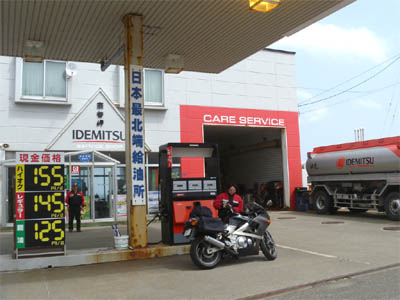
There are so many gas stations in Japan. Almost all gas stations are open on holidays. There are also many 24-hour gas stations.
However, please be careful when riding a motorcycle in Hokkaido. In Hokkaido, there are areas where there are few gas stations.
Self Service Gas Station
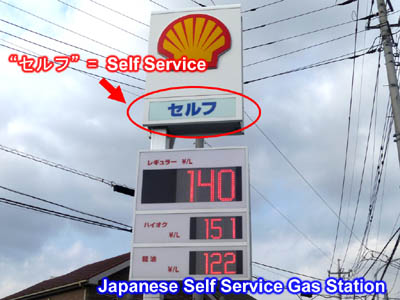
There is a self-service gas station in Japan. The self-service gas station sign is written as "セルフ". You can pay by credit card at a self-service gas station.
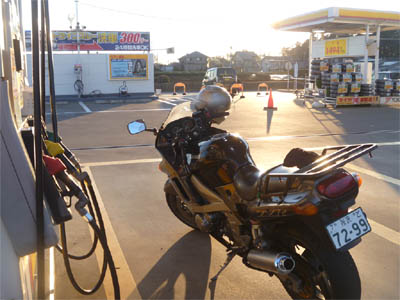
Refueling at a self-service gas station is easy. Most self-service gas stations have a display on top of the refueling hose, and a guide message is also displayed in English. Let's refuel according to the guide message. The red refueling hose is for regular gasoline. The yellow refueling hose is for high-octane gasoline. The green refueling hose is for light oil.
There are also clerks at self-service gas stations. If you don't know how to refuel, call a clerk.
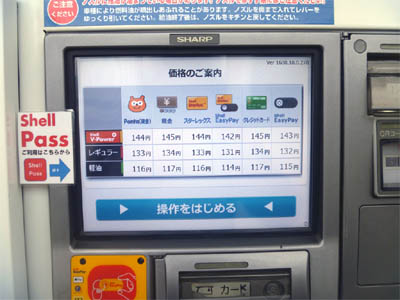
The operation method (fueling method) of the gas station displayed only in Japanese is explained on another page.
Air Pump
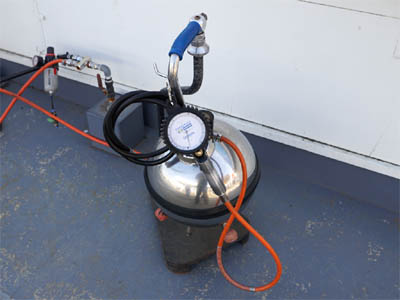
Most gas stations have an air pump. However, Japanese air pumps are often used for cars. You may need an air charge hose to inflate the motorcycle tires.
9. Stores
Convenience Stores

There are many convenience stores in Japan. Most of the things you need for travel can be purchased at convenience stores. At the convenience store, you can go to the restroom.
Roadside Rest Areas "Michi-no-Eki"
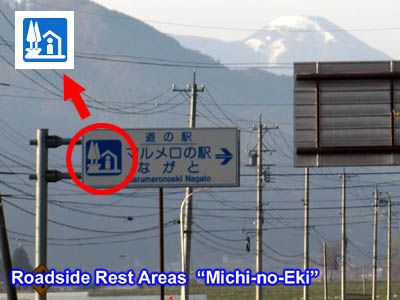
In Japan, there is a rest facility called "Michi-no-Eki". The image on the left is the signboard of "Michi-no-Eki". "Michi-no-Eki" has vending machines, shops, cafeterias and restrooms. It's a very convenient facility.
10. Parking
Motorcycle Parking
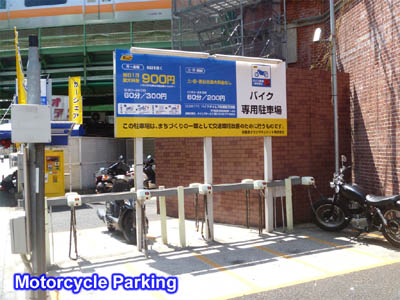
Recently, the number of motorcycle parking lots has increased around Tokyo. However, the number of motorbike parking lots in Japan is still very few. Japanese parking violations also apply to motorcycles.
Hotel parking lot

Some hotels in Japan do not have a parking lot. In particular, hotels near the station may not have parking. We recommend that you check the availability of parking before booking a hotel.
11. Police and Emergency Vehicles
Police Car
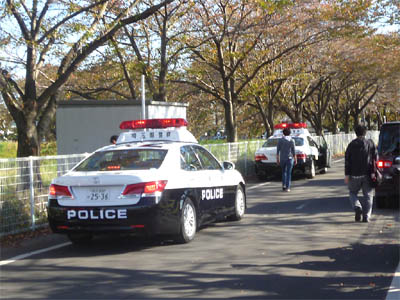
The major traffic violations that occur in Japan are speeding and parking violations. Japanese police cars may be hidden in the blind spot of the intersection. In the color of Japanese police cars, the upper half of the car is white and the lower half is black.
Motorcycle Police
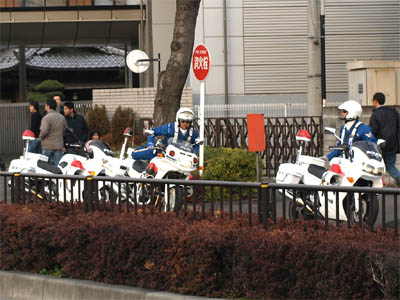
In the streets of Japan, you can often see motorcycle police. We call it "Shiro-bai". It means the "White Motorcycle".
Emergency Vehicle

As the emergency vehicle approaches, stop the motorcycle on the left side of the road. The color of the Japanese ambulance is white and the fire engine is red.
12. Traffic violation
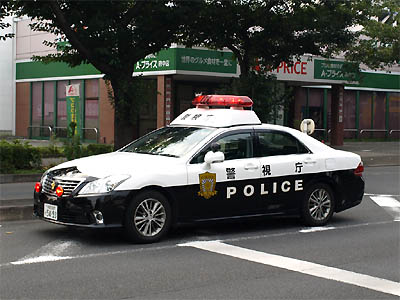
If the police ask you to stop, move to the left side of the road and stop. However, on expressways, police cars may lead you to a safe location.
Usually, a police officer who gets out of a police car will give you an overview of the traffic violation and then instruct you to go inside the police car.

If you make a minor traffic violation, the police officer will give you a "traffic violation notice" called "Blue ticket" on the spot. If you receive this ticket and pay the fine by the specified date, you will not be prosecuted.
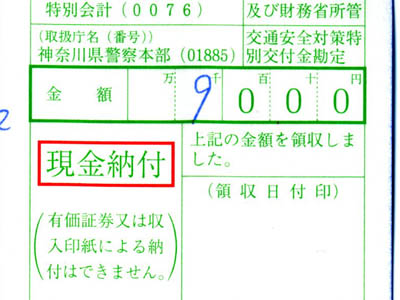
If you make a minor traffic violation, you will also be given a payment slip for the penalties in addition to the above-mentioned "traffic violation notice". The amount of the fine and the deadline for payment are written on this paper. You can pay the fine at the bank or post office in Japan.
13. Trouble Shooting
Motorcycle Shop
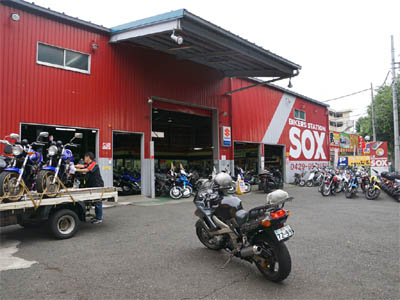
There are many motorcycle shops in Japan. If you have trouble during touring, ask a nearby motorcycle shop for repair.
Motorcycle Chain Store
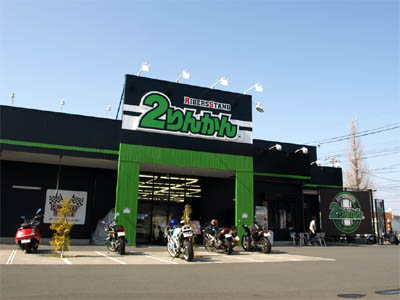
There is also a motorcycle chain store. One of the famous chain stores is "Ni-rin-kan". This store always sells many motorcycle parts. Most stores are open 7 days a week.
Traffic Accident
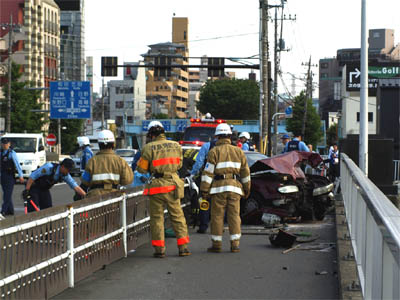
If an accident occurs during touring, call the police. The Japanese police phone number is "110". If you need to call an ambulance, call "119".
14. Car Ferry

As Japan is an island country, there are many car ferry routes. The car ferry on the long-haul route has a sleeping room. You can travel far by using the car ferry.
15. Motorcycle Rental

There are also rental motorcycle shops in Japan. But, the number of rental motorcycle shops is very few. If you want to rent a motorcycle in Japan, check the store beforehand.
16. Japanese Season
Four seasons
There are four seasons in Japan. Spring and autumn are the best seasons for traveling on a motorcycle. However, it's hard to travel by motorcycle in summer and winter.
Very Hot Summer

Japan's summer is very hot. It's very uncomfortable because of the high humidity. In recent years, summer temperatures in Japan have risen.
Rainy Season

There are rainy season in Japan. The Japanese rainy season is mainly from June to July. In addition, a typhoon comes in summer and early fall in Japan.
Snow Season
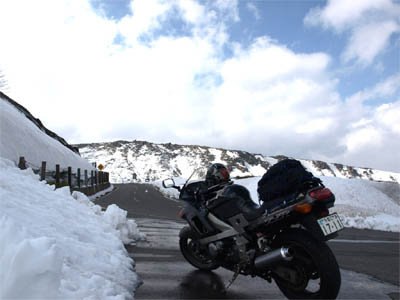
When it comes to winter, snow falls on a road in Japan. From late December to early March, snow may fall nationwide. In Hokkaido, it may snow even in May. In high mountain areas, snow remains on the side of the road even in May. The image on the left is a picture taken in May.

Even in Tokyo, when you wake up in the morning, motorcycles may be buried in snow. Please be careful if you come to Japan from a country that doesn't snow.
Night Driving
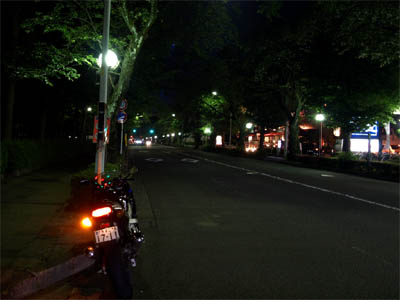
In urban areas of Japan, you can ride a motorcycle without problems at night. However, be careful if you ride a motorcycle at night on roads other than urban areas. Some roads have no street lights at all. Japan's summer sunset time is around 19:00. Japan's winter sunset time is around 17:00.
